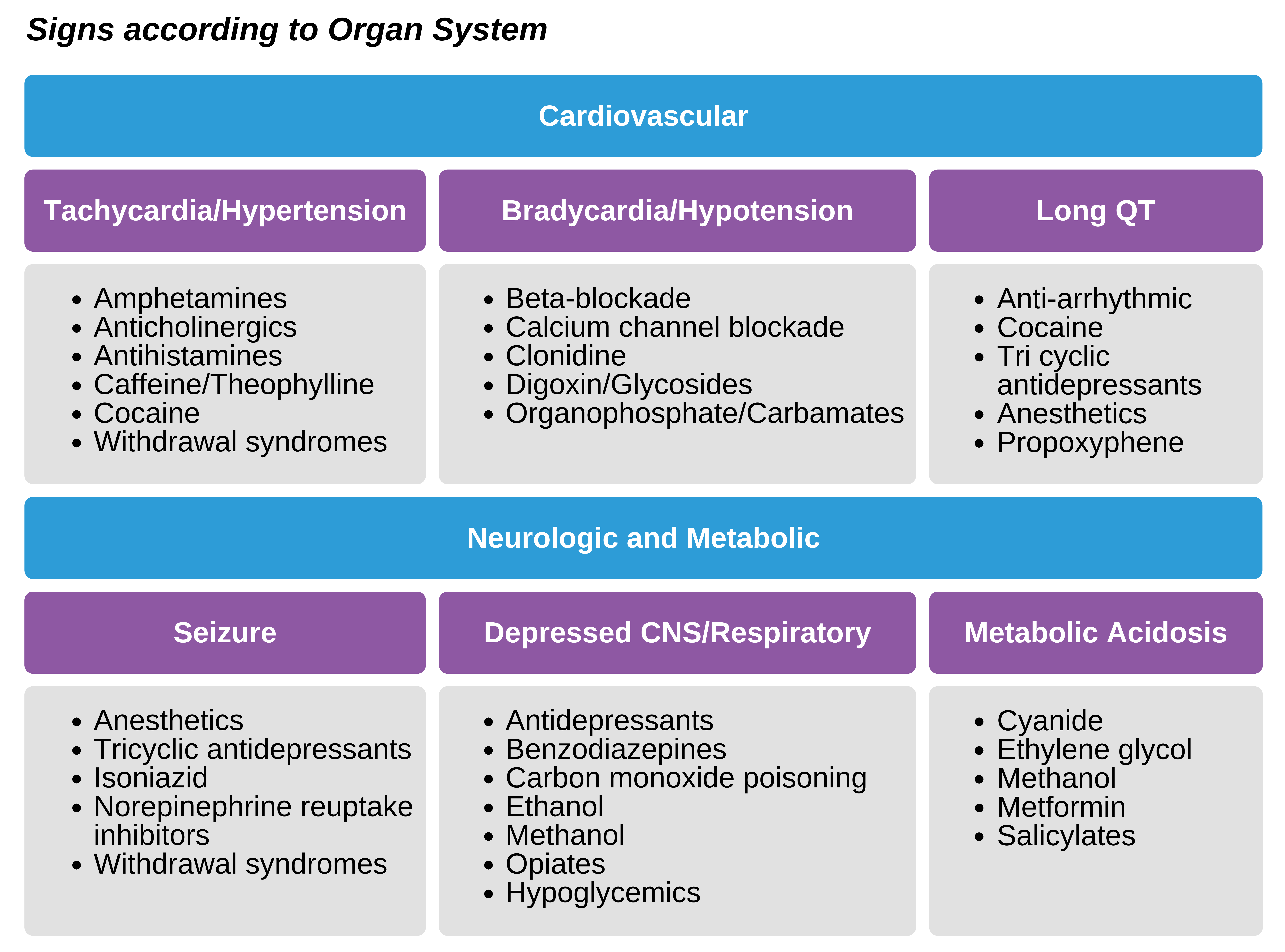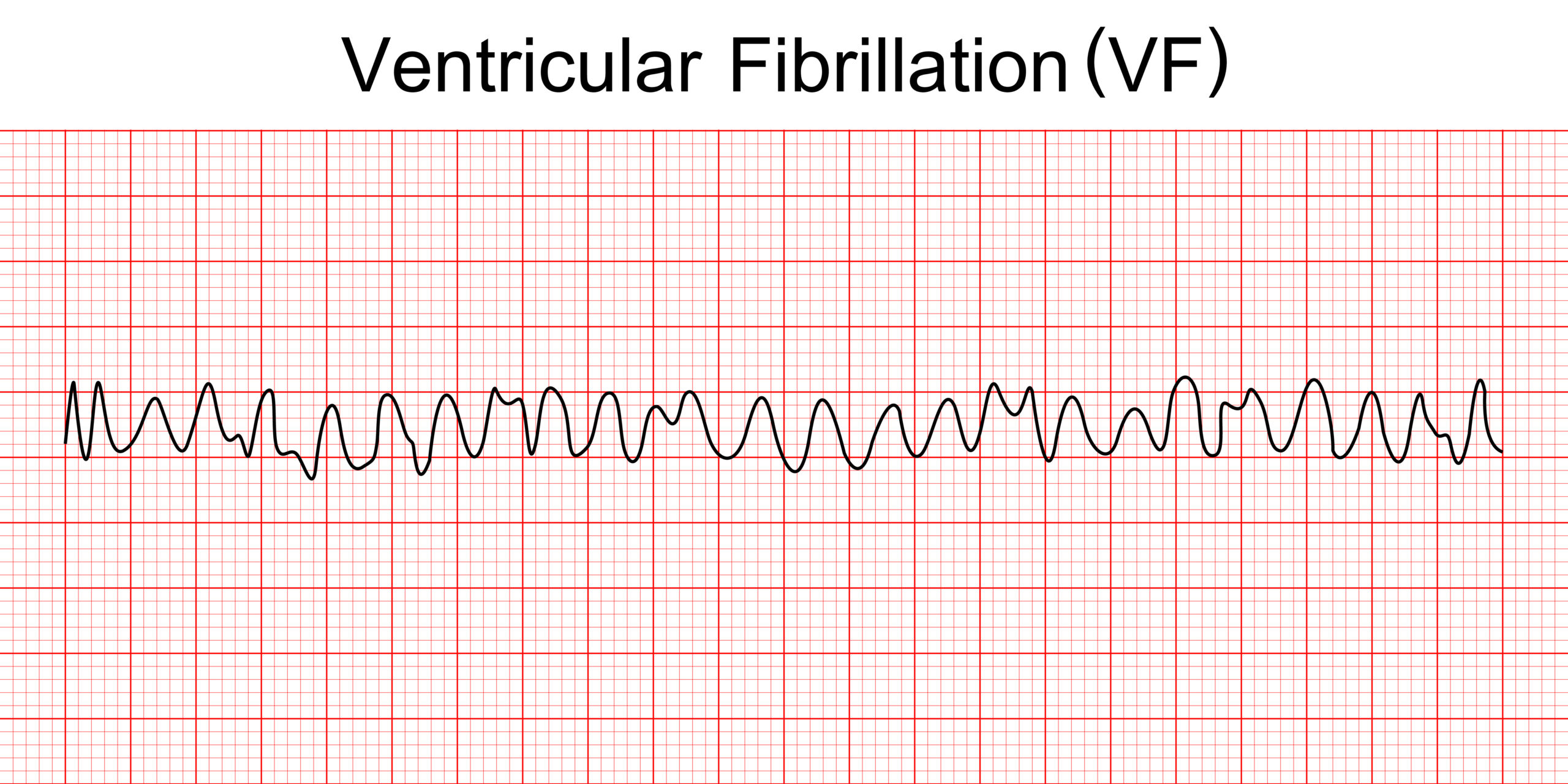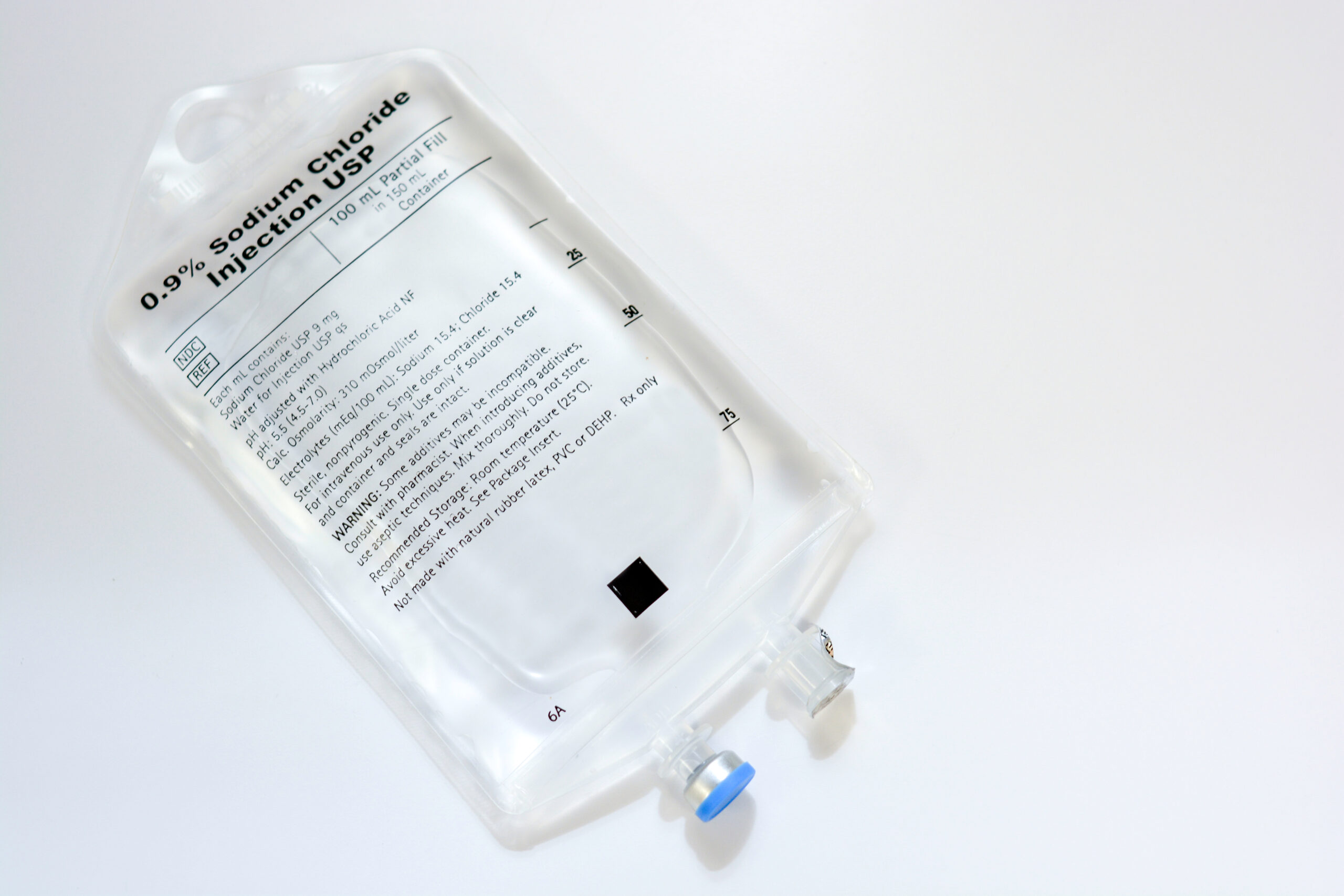Organ-Based Management
The signs of toxin ingestion are not specific and are found in nearly all other illness categories. As a result, the differential will be quite large, and health care responders must keep the toxidromes in mind when the clinical history is suspicious to evaluate these patients best.

Toxin Associated Cardiac Arrest
Toxins can lead to cardiac arrest due to numerous effects on the heart: asystole/PEA or VF/pulseless V-Tach. Defibrillation is appropriate for VT/V-Tach or polymorphic VT when there is no pulse. If VF is refractory, the dose of epinephrine is maintained, but the interval is increased. Do not use propranolol in the case of cocaine overdoses, but it may be beneficial in epinephrine or pseudoephedrine toxicities.
Prolonged Resuscitative Efforts.
In patients who have toxin ingestion, especially in the case of calcium channel blockade, prolonged resuscitative efforts may be warranted. Studies indicate that there can be good neurologic recovery even after CPR lasting 3-5 hours.
Mechanical Cardiac Support
Cardiac supportive measures can be used in toxic ingestion that remains refractory to emergency care. Such supportive therapies include intra-aortic balloon pump (IABP) and cardiopulmonary bypass. These treatments are labor-intensive, expensive, and have significant adverse events. They must be used early in treatment and, in the case of IABP, must be used in patients with intrinsic cardiac activity.
Organ Donation and Irreversible Brain Damage
Criteria for irreversible brain damage is defined differently in cases of toxin exposure. The use of a neurologic exam and EEG is only valid in cases without toxic exposure. In cases of toxin ingestion, findings indicating a complete loss of blood flow will diagnose the condition.
There is controversy regarding the benefit of organ donation in the case of multiple organ failure from toxic exposure. Consultation with toxicologists and transplant physicians may be indicated. With careful consideration, there may be benefits in cases of cyanide, methanol, carbon monoxide, and acetaminophen exposure.
Be aware that transplants with target organs for toxins will likely fail. Examples include the heart following carbon monoxide toxicity, the kidney and liver following acetaminophen toxicity, and the liver and heart following cocaine or iron toxicity.
Ventricular Fibrillation and Tachycardia
Toxin-induced V-Tach or VF may not be distinguishable from wide QRS from conduction abnormalities based on the EKG. Other clinical information may be required to do this.
In the case of VF or pulseless V-Tach, defibrillation is indicated. If the patient is unstable with pulses, choose electrical cardioversion as noted on the algorithm for tachycardias. Be aware that when toxin associated, arrhythmias may persist following electrical therapies.
Key Takeaway
Toxin associated V-Tach
In a patient exposed to a toxin, a wide QRS rhythm and hypotension should raise suspicion for V-Tach. If polymorphic V-Tach occurs and the patient becomes unstable, provide defibrillation

Ventricular Fibrillation ECG
Antiarrhythmic medications should be used in stable toxin-induced V-Tach. However, class IAc and Iab medications blocking fast-acting sodium channels (i.e., sotalol) should not be given when the toxin also causes fast-acting sodium channel blockade (i.e., tricyclic antidepressant, sympathomimetics). Do not give phenytoin for tricyclic antidepressant management. Also, health care providers should be aware that magnesium can potentiate toxin associated hypotension.
Lidocaine
Lidocaine is used to managed arrhythmias related to cocaine-associated acute MI. There is no evidence for or against lidocaine use when a wide QRS tachycardia is associated with cocaine.
Propranolol
Do not use in sympathomimetic toxins, including cocaine overdose.
Procainamide.
Do not use for tricyclic antidepressant toxin exposures or other toxins with type IAvw effects, as this may cause a prolonged QT duration.
Magnesium
Its use is beneficial in toxin associated VT but can potentiate any associated hypotension.
Amiodarone
Studies indicate that refractory toxin-associated V-Tach and VF may be managed with amiodarone. As it can potentiate any associated hypotension and may increase the risk of other arrhythmias, it should be used cautiously.
Epinephrine
It is unclear the benefit of epinephrine for refractory toxin associated VF. If used, prolong the interval for subsequent doses and only use 1 mg dosing.
Sodium Bicarbonate
Sodium bicarbonate may be used for toxin-induced wide QRS tachycardias. However, the research is based on positive findings from wide QRS tachycardias due to non-toxin etiologies.
Torsades de Pointes
Torsades may be due to toxin ingestion or may be a response to therapeutic medications. Torsades is more likely to occur with certain illnesses, including hypokalemia, hypomagnesemia, and hypoxemia. Many of the recommendations for toxin-induced arrhythmia have not specifically been evaluated in polymorphic V-Tach. Yet, magnesium is recommended to treat Torsades even with normal magnesium levels. Treatment suggestions include
- Managed electrolyte abnormalities and hypoxia
- Administer 1-2 g IV magnesium in 10 mL d5W even if levels are normal.
- Lidocaine may be given
- Pacing at 100-120 beats/min
- 2-10 mcg/kg/h IV isoproterenol for pharmacologic pacing
- Consider administering potassium even if levels are normal.
Some medications associated with torsades include sotalol, digoxin, furosemide, amiodarone, quinidine, loratadine, fluoxetine, procainamide, fluconazole, terfenadine, ibutilide, thioridazine, haloperidol, erythromycin, cisapride, terfenadine, and others.
Shock
Shock due to toxin exposure can occur through the following mechanisms:
- Intravascular volume decrease
- Systemic vasculature resistance (SVR) decrease
- Cardiac contractility decrease
These mechanisms make toxin associated shock very resistant to usual treatments.
Hypovolemic Shock and normal SVR
Some toxins/overdoses can lead to significant GI fluid losses resulting in hypovolemia. However, in these cases, there is often cardiac dysfunction or decreased SVR requiring fluid replacement and cardiac support.
Fluid Resuscitation
Patients should receive a fluid bolus (usually 250- 500 mL normal saline) to improve volume status. Be aware that if the toxin is toxic to the cardiac muscle, and the patient is intolerant to fluid excess, this may cause heart failure and associated pulmonary edema.

Normal Saline for Fluid Resuscitation
Vasopressive and Ionotropic Medicines
If shock is resistant to IV fluid, administer vasopressive or ionotropic medicines. An initial 2-20 mcg/kg dose of dopamine is a useful medication that has both properties. If this is not successful, increase vasopressive action with norepinephrine as there may be excess vasodilation from the toxin. Epinephrine can also be used to support both heart rates and vascular resistance. These patients will need continuous blood pressure monitoring with central access. Titrate medications as needed based on SVR and cardiac output.
Distributive Shock and normal volume
In this case, SVR will be low, and there may be normal or high cardiac output as compensatory mechanisms.
Key Takeaway
Toxin associated Distributive Shock
Causes hypotension and normal/high cardiac output with low SVR
Consider alpha-adrenergic medications such as norepinephrine and phenylephrine
Do not give isoproterenol or dobutamine
Norepinephrine and phenylephrine, vasopressors with strong alpha-adrenergic agonism, are useful in these situations to increase vascular resistance. Patients may need doses at supratherapeutic levels due to the inherent resistance associated with some toxic states. Additionally, ensure monitoring to rule out ventricular associated arrhythmia. Vasopressin may also be useful in cases when arrhythmias limit the use of other vasopressive medications. Endothelin is a newer vasopressive medication that is not well studied
Cardiogenic shock
Toxin-associated cardiogenic shock will lead to poor outcomes and decreased SVR. Patients may also have myocardial ischemia. Ionotropic support may be needed with dobutamine, as well as other medications such as calcium, milrinone, glucagon, insulin, and isoproterenol. More than one inotrope may be needed in addition to vasopressive medicines.